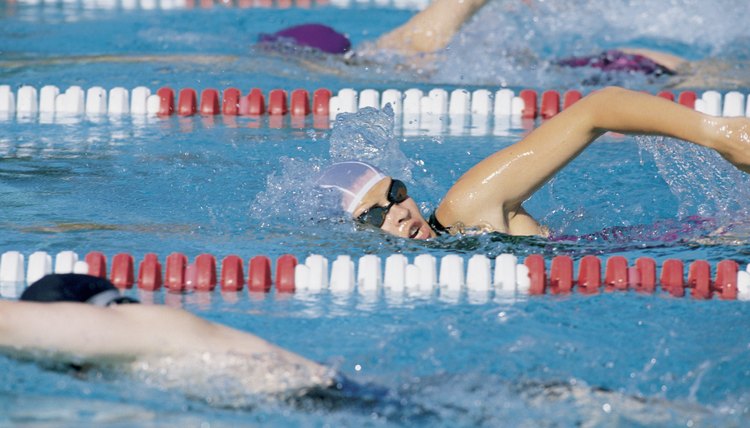Should I Swim With Ankle Weights?

Swimming improves your cardiovascular fitness and works out your muscle groups, but you might want to ramp up the intensity of your workouts with ankle weights. You use all major muscle groups when you swim, but adding weight increases the resistance you must overcome when you kick to stay afloat and move forward. They may not be your best alternative, though.
How the Weights Work
Ankle weights function to add difficulty to your workout. Every time you move your legs and feet, you move extra weight. Because you exert your muscles more, you burn more calories and you increase the work your muscles perform. In theory, you build up your muscle strength as you perform standard exercise such as swimming.
Effects on Body Alignment
Swimming is a technique-intensive sport, and your stroke depends on your position in the water. Because water is buoyant, you avoid strain on your joints often associated with high-impact sports such as running. Yet even in the water, you put pressure on different parts of your body because of repetitive movements and the need to overcome the resistance of water. Proper alignment in the water helps avoid injury and pain resulting from overloading one part of your body with too much stress. Ankle weights tend to make you "bottom heavy" and force you to compensate by realigning your body in the water.
Potential Problems
You add many potential problems along with the ankle weights to your swimming routine. In a "Los Angeles Times article," Kent Adams, director of the exercise physiology lab at Cal State Monterey Bay, cautions against using ankle weights during cardiovascular exercise. He explains that you put extra stress on your knees as they must accommodate the extra load when you kick. Tendons and ligaments also might suffer from over work. Any extra weight on one part throws you out of balance, according to Adams. In swimming, you make up for the excess weight by changing your body position in the water and potentially straining your lower back muscles.
Skip the Weights
Rather than forcing a swim workout to be what it is not, dedicate a separate workout to weightlifting. Swimming’s repetitive movements work out your muscles over time. Short sets of weightlifting are better suited to building lean muscle mass. Instead of ankle weights, use a drag suit -- which is a looser-fitting suit worn over your regular tight-fitting one -- to increase the water’s resistance and your energy expended swimming laps. Perform kicking sets holding a kick board in front of you and perpendicular to the surface of the water, rather than parallel to it as is customary. You kick harder to move forward, much like swimming against a current, according to the Los Angeles Times article.
Obtaining Advice
Check with a physician if you experience pain or injury after swimming. Changing stroke technique sometimes results in temporary stiffness or discomfort. Adding a weightlifting routine to your regular swimming workouts is beneficial and targets specific muscle groups for strengthening, but seek professional guidance on the best way to use weight machines and free weights before you begin.
References
Writer Bio
Barrett Barlowe is an award-winning writer and artist specializing in fitness, health, real estate, fine arts, and home and gardening. She is a former professional cook as well as a digital and traditional artist with many major film credits. Barlowe holds a Bachelor of Arts in English and French and a Master of Fine Arts in film animation.
